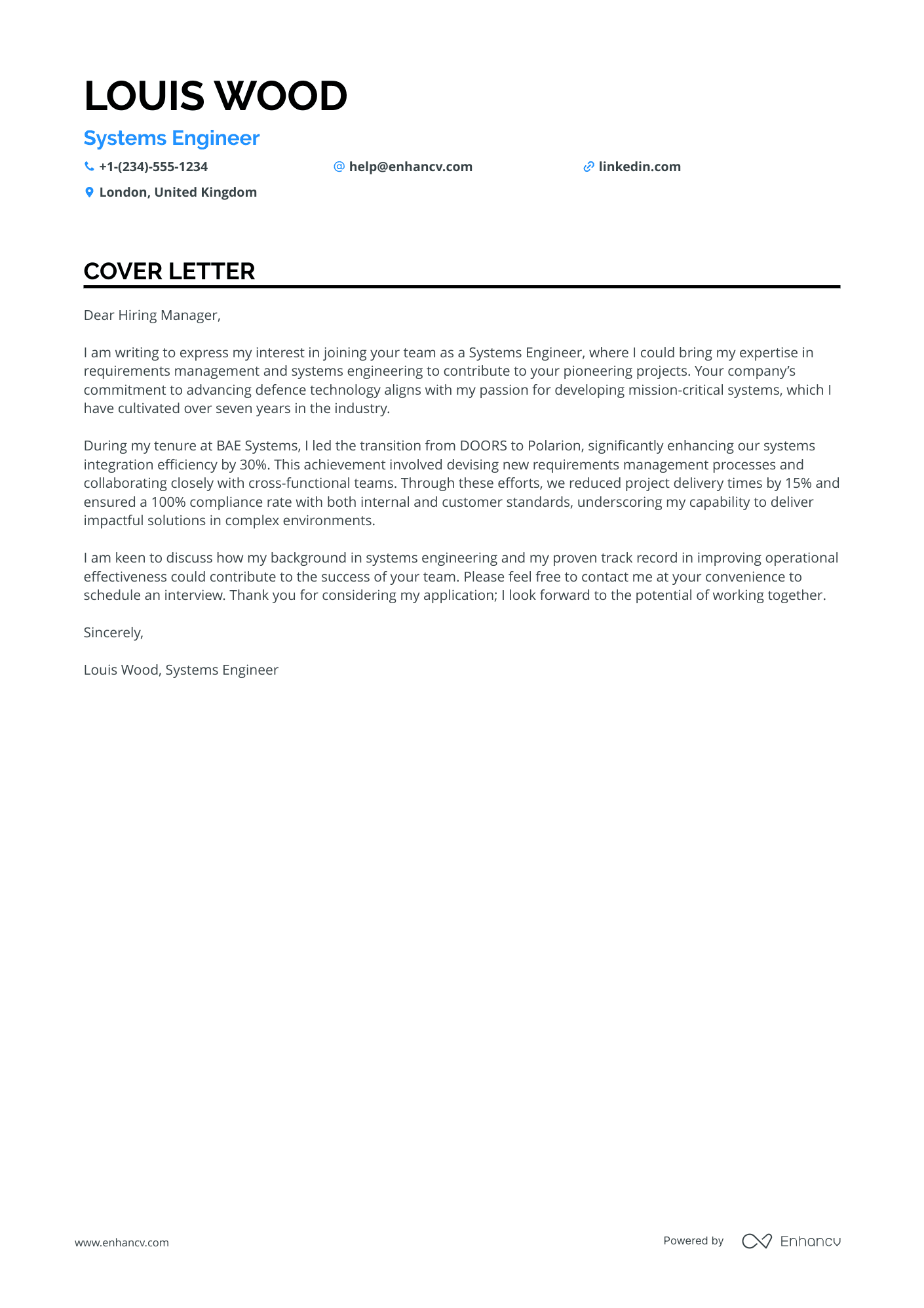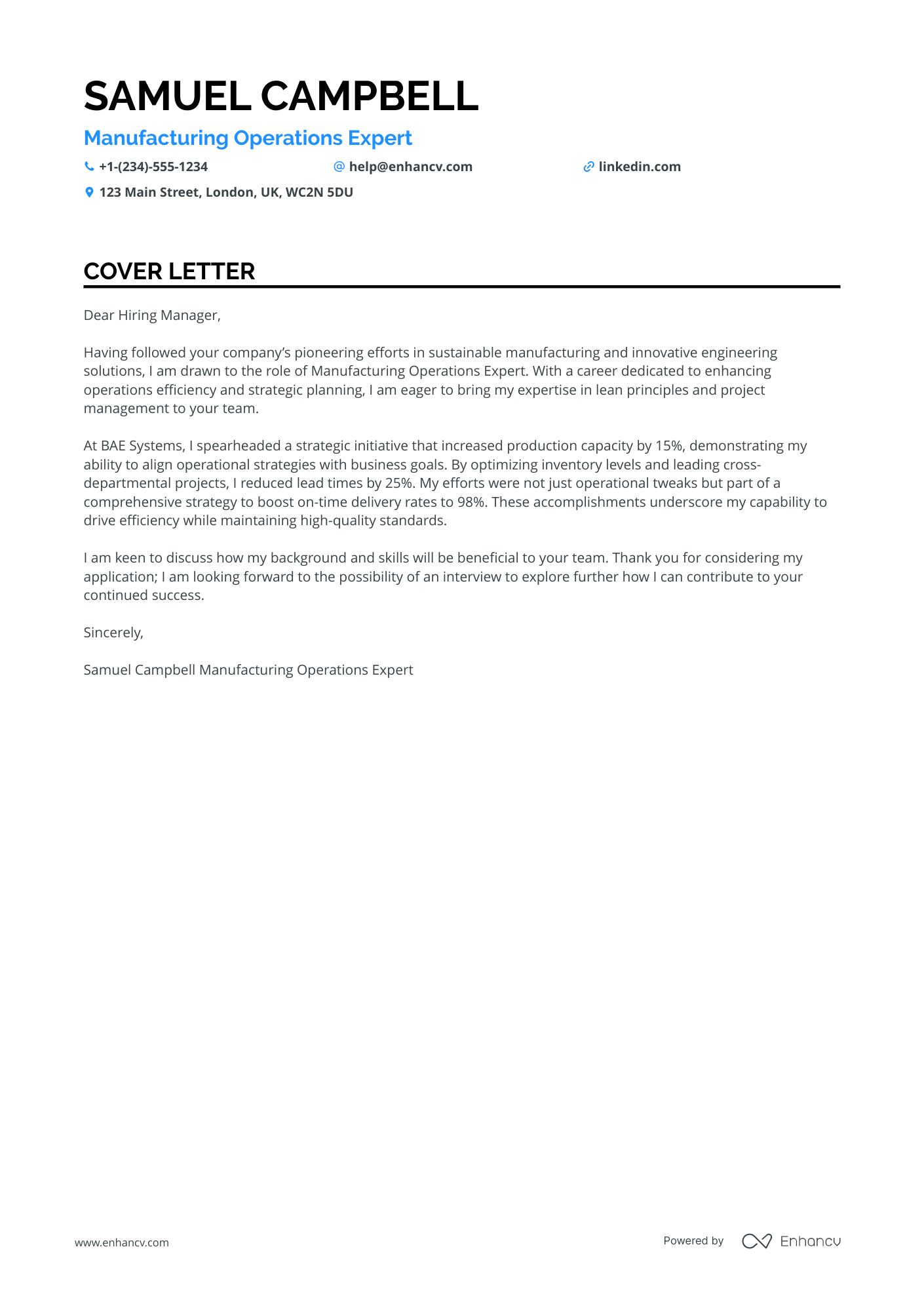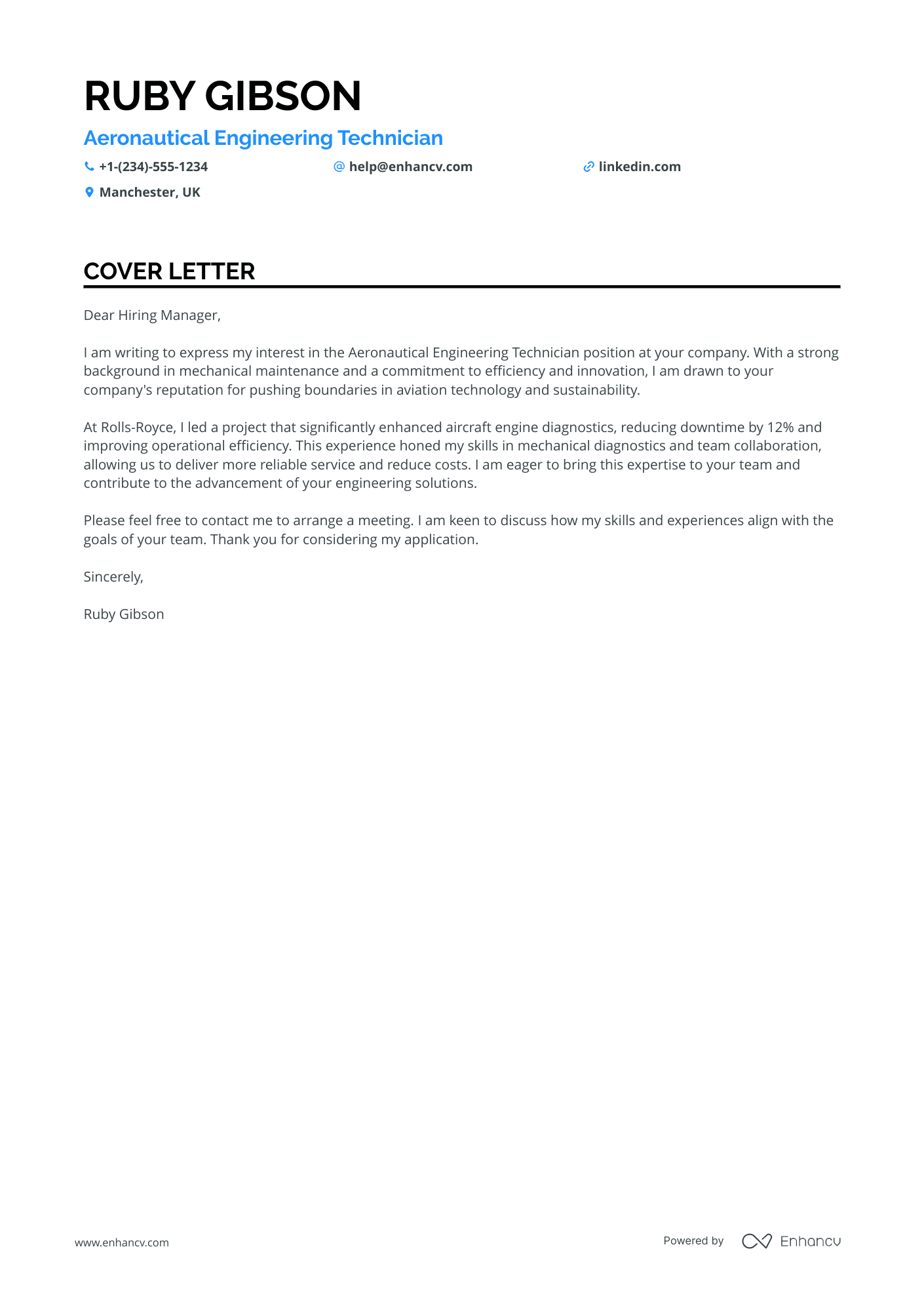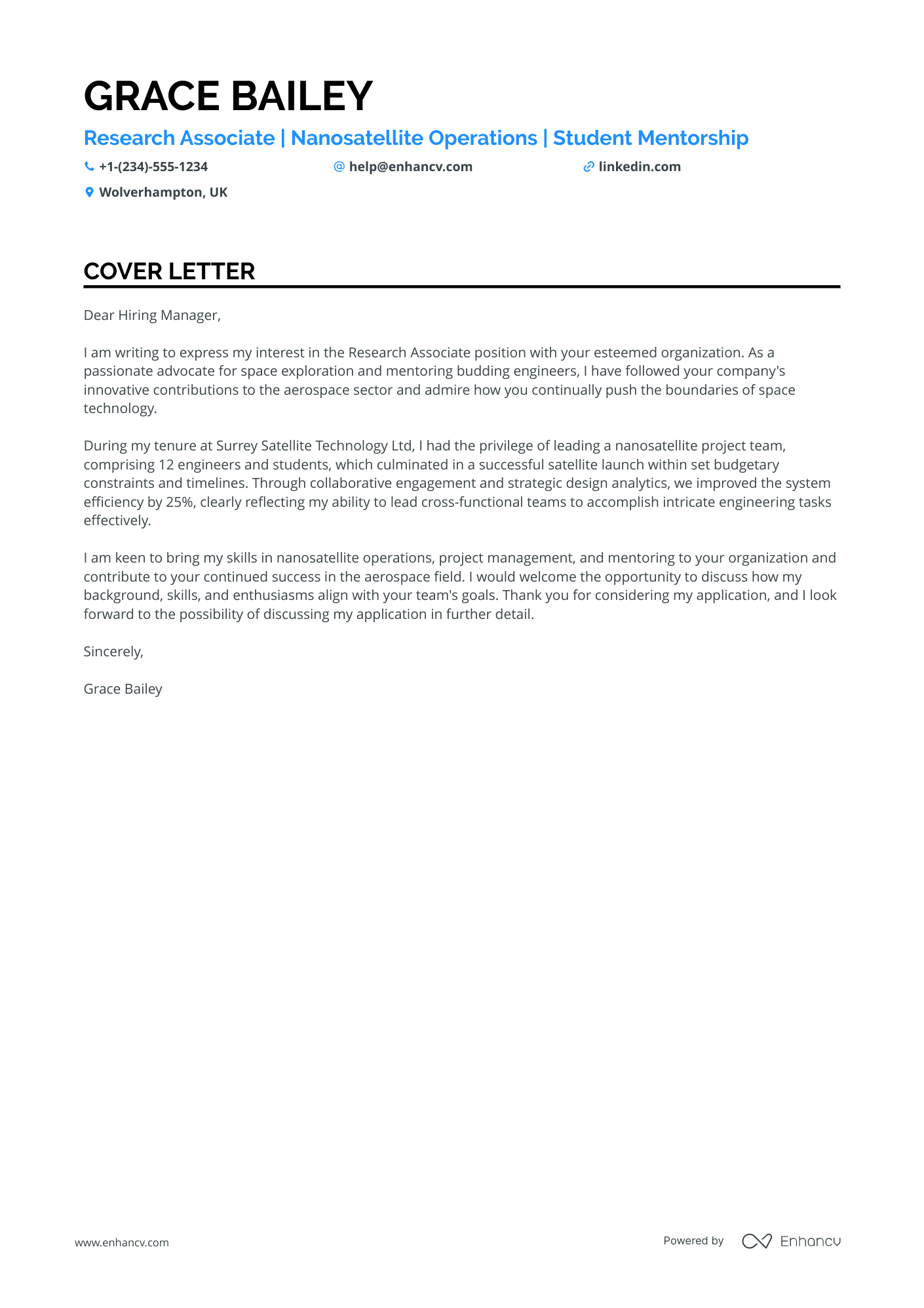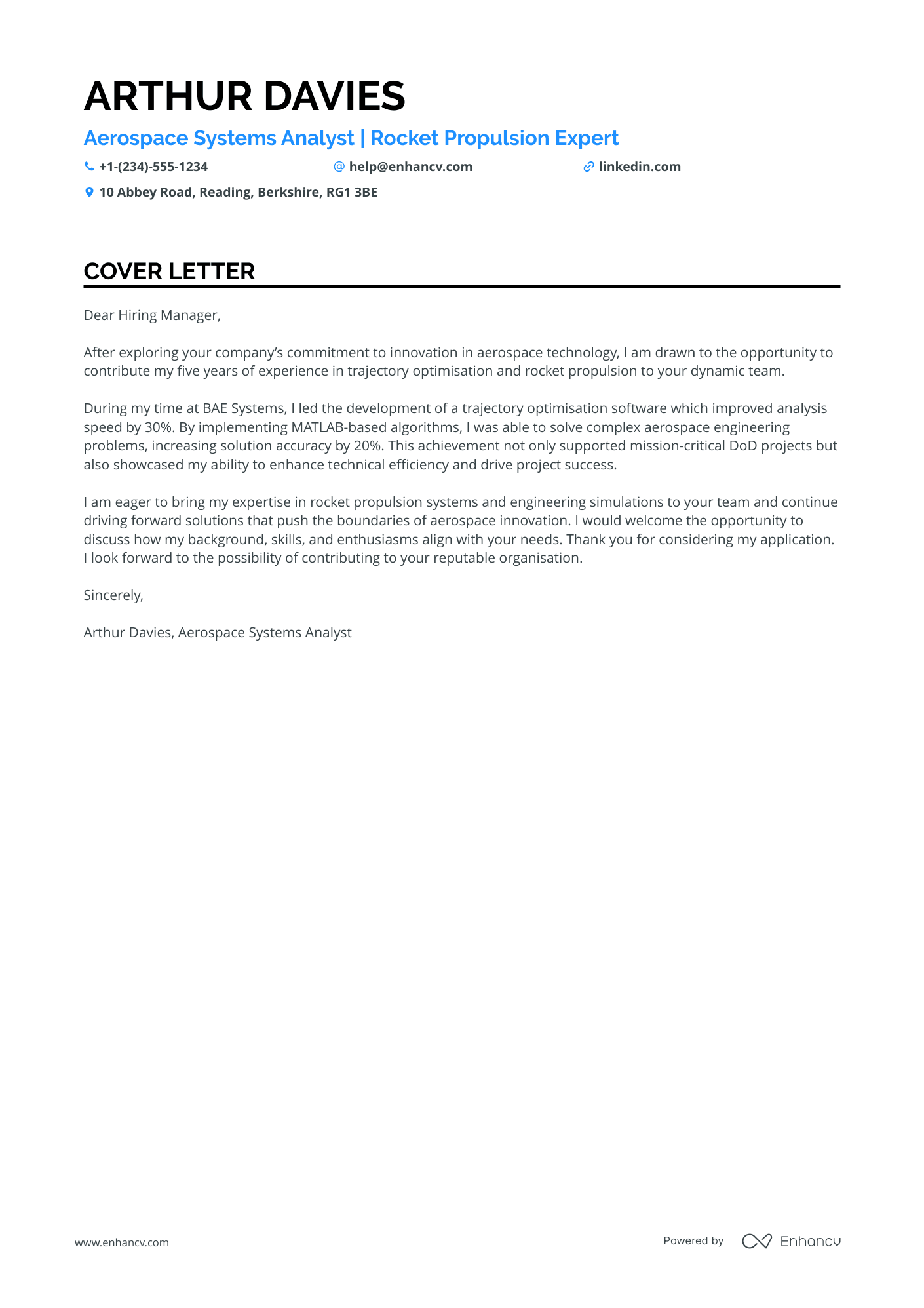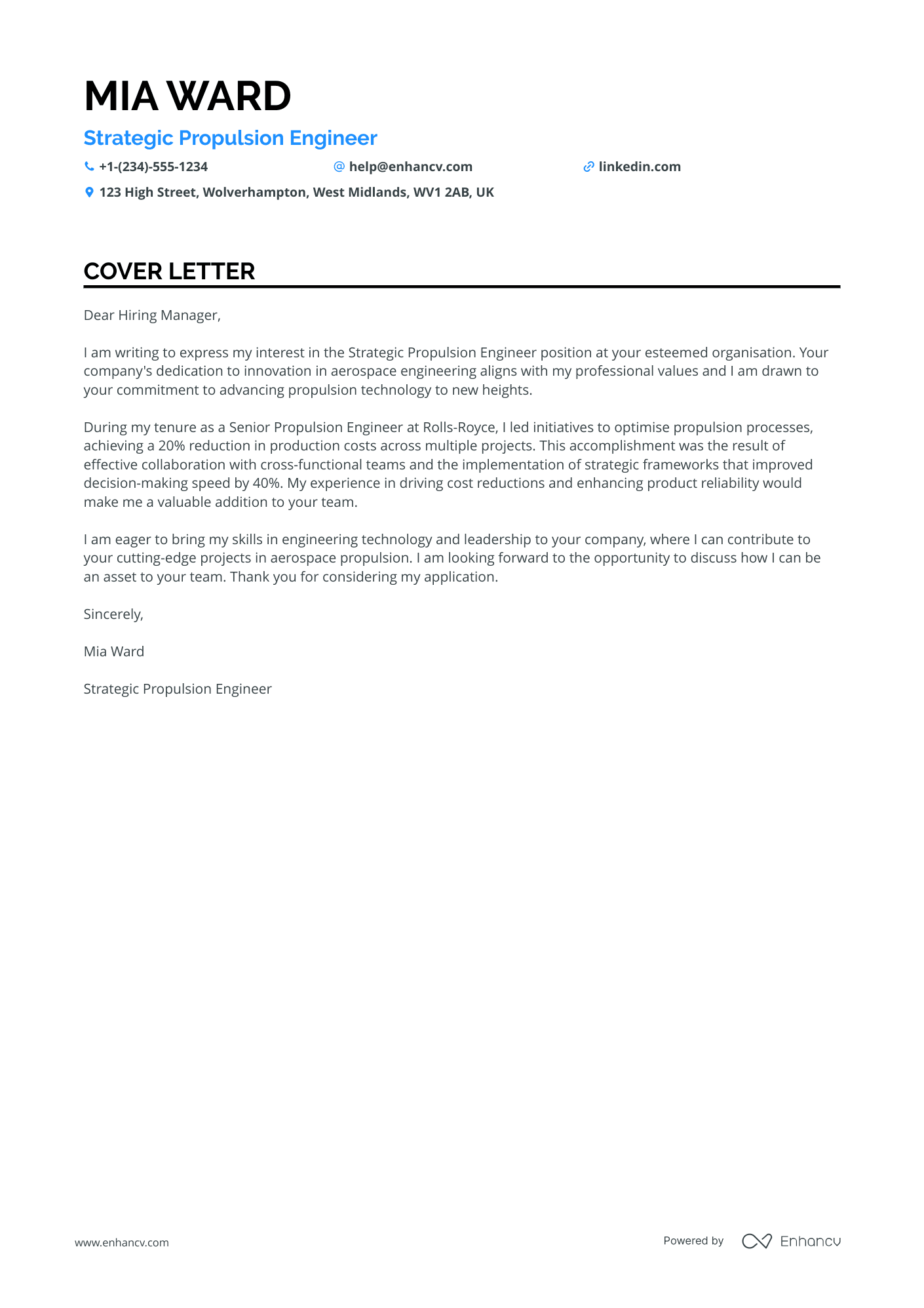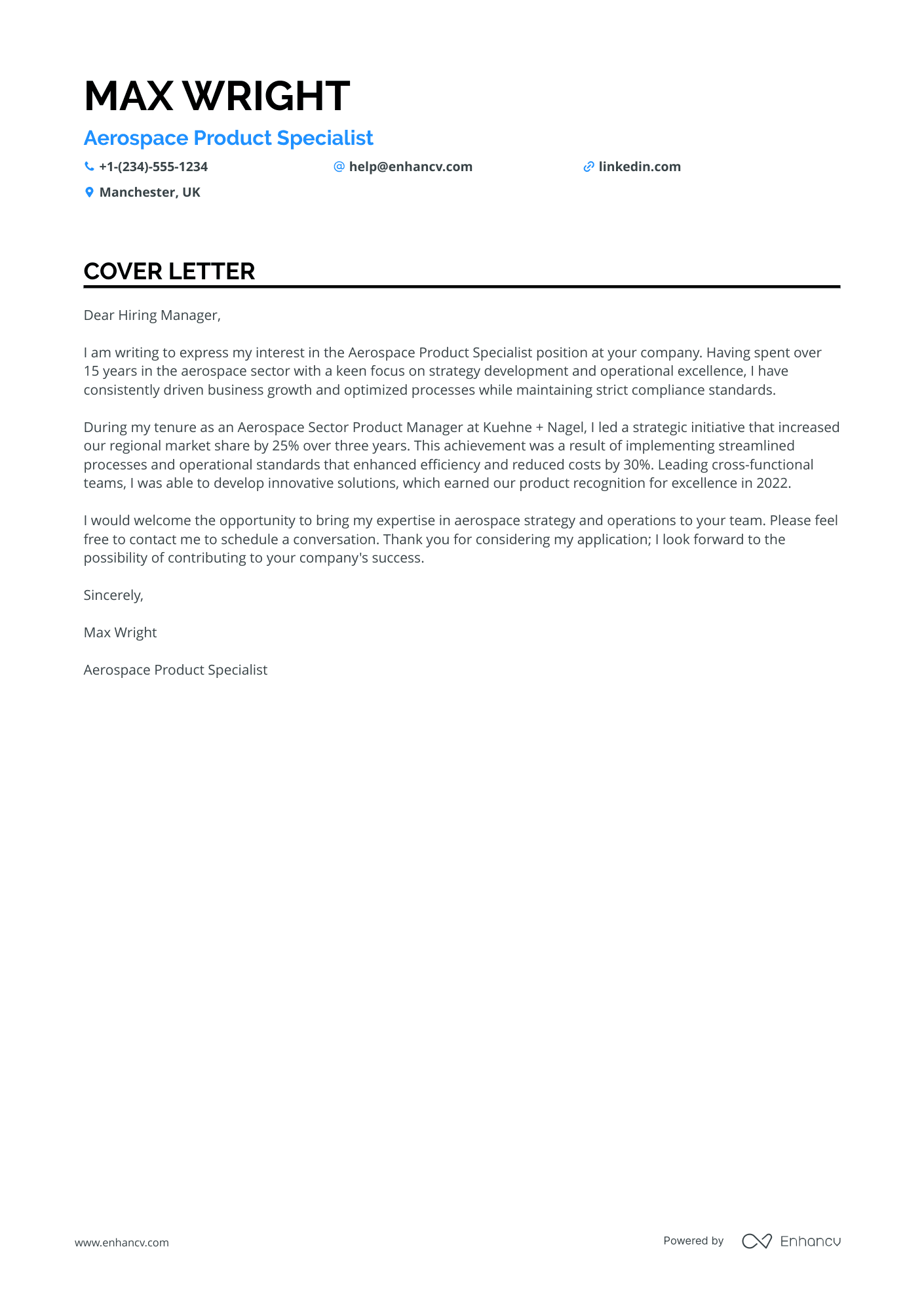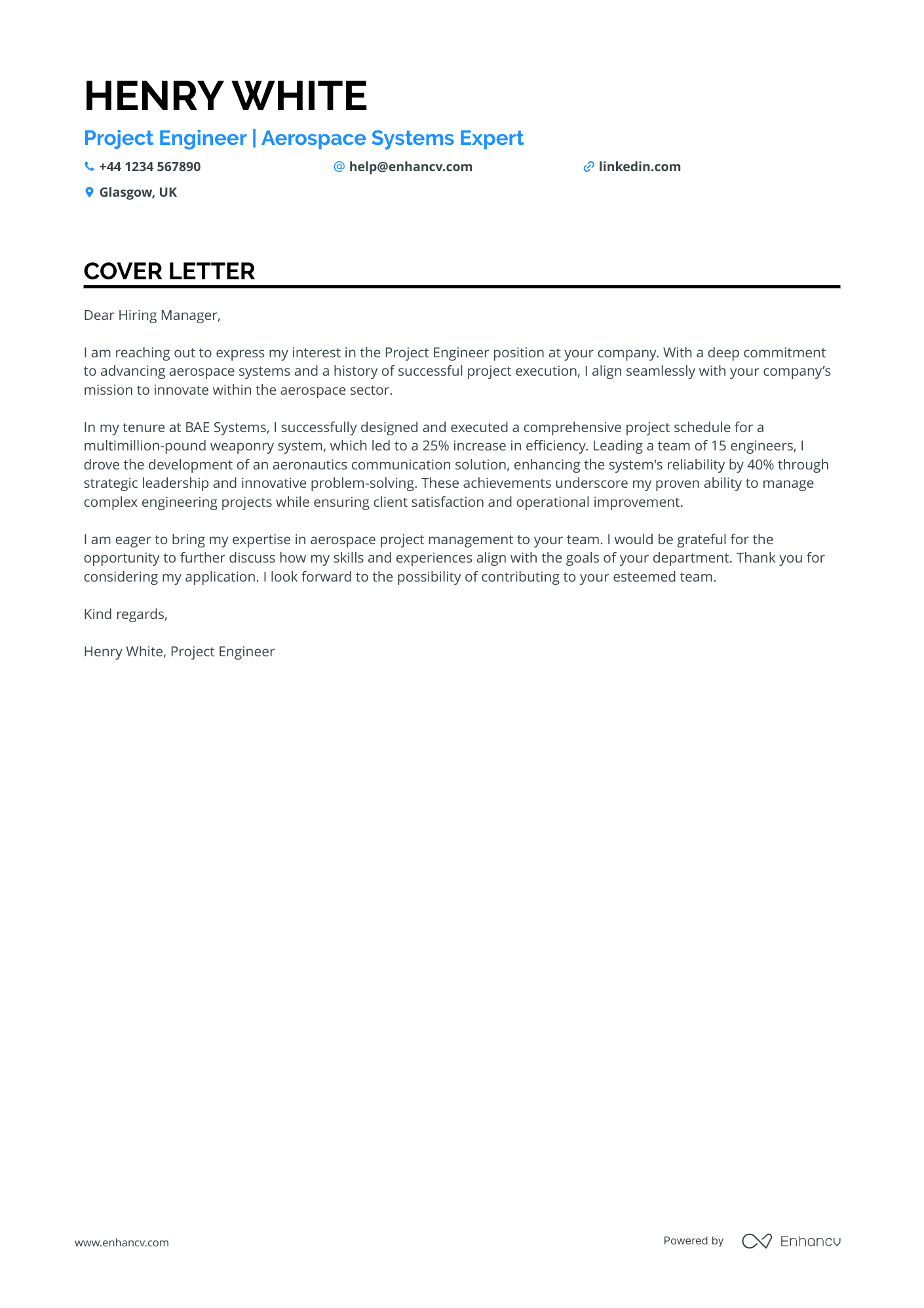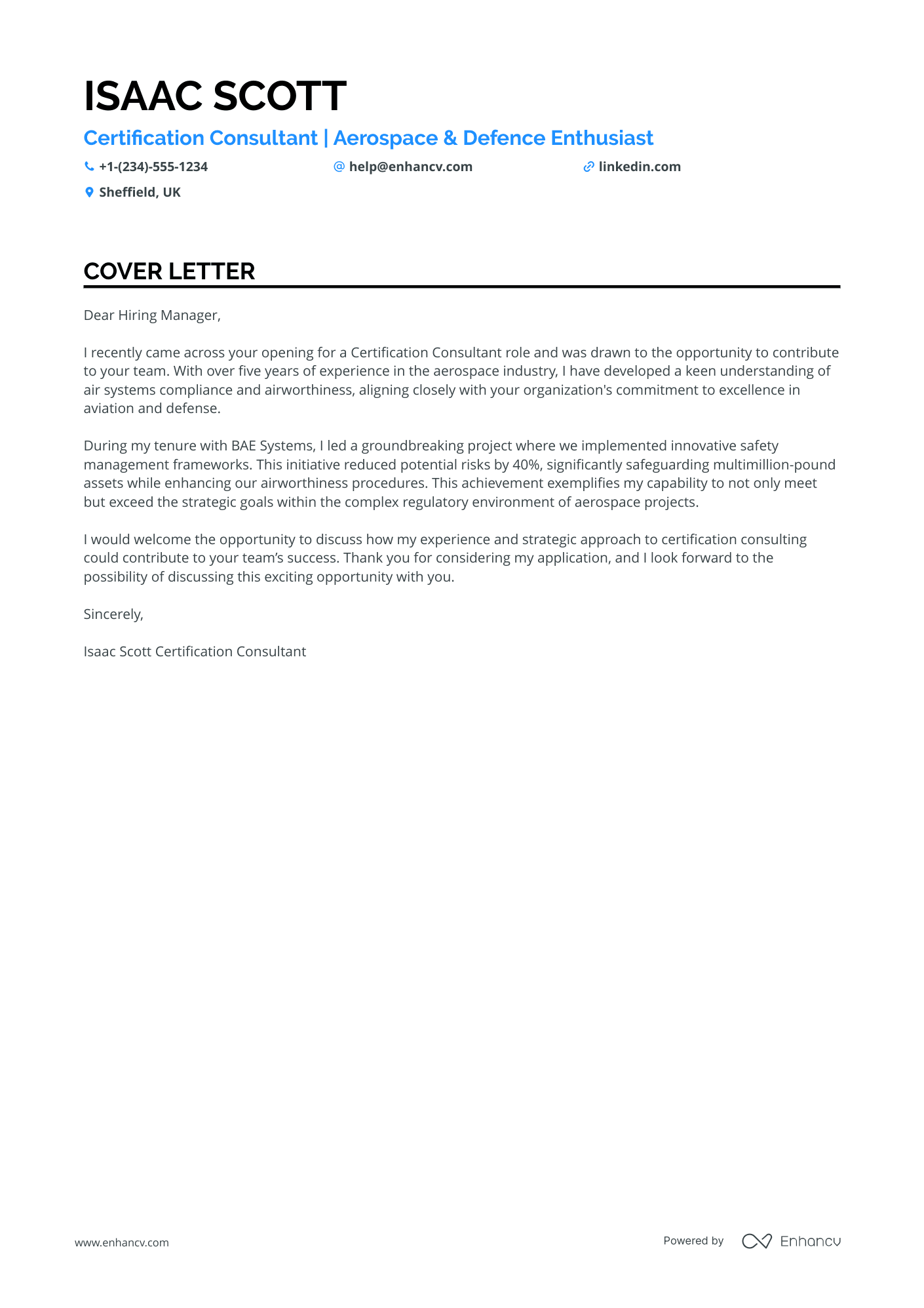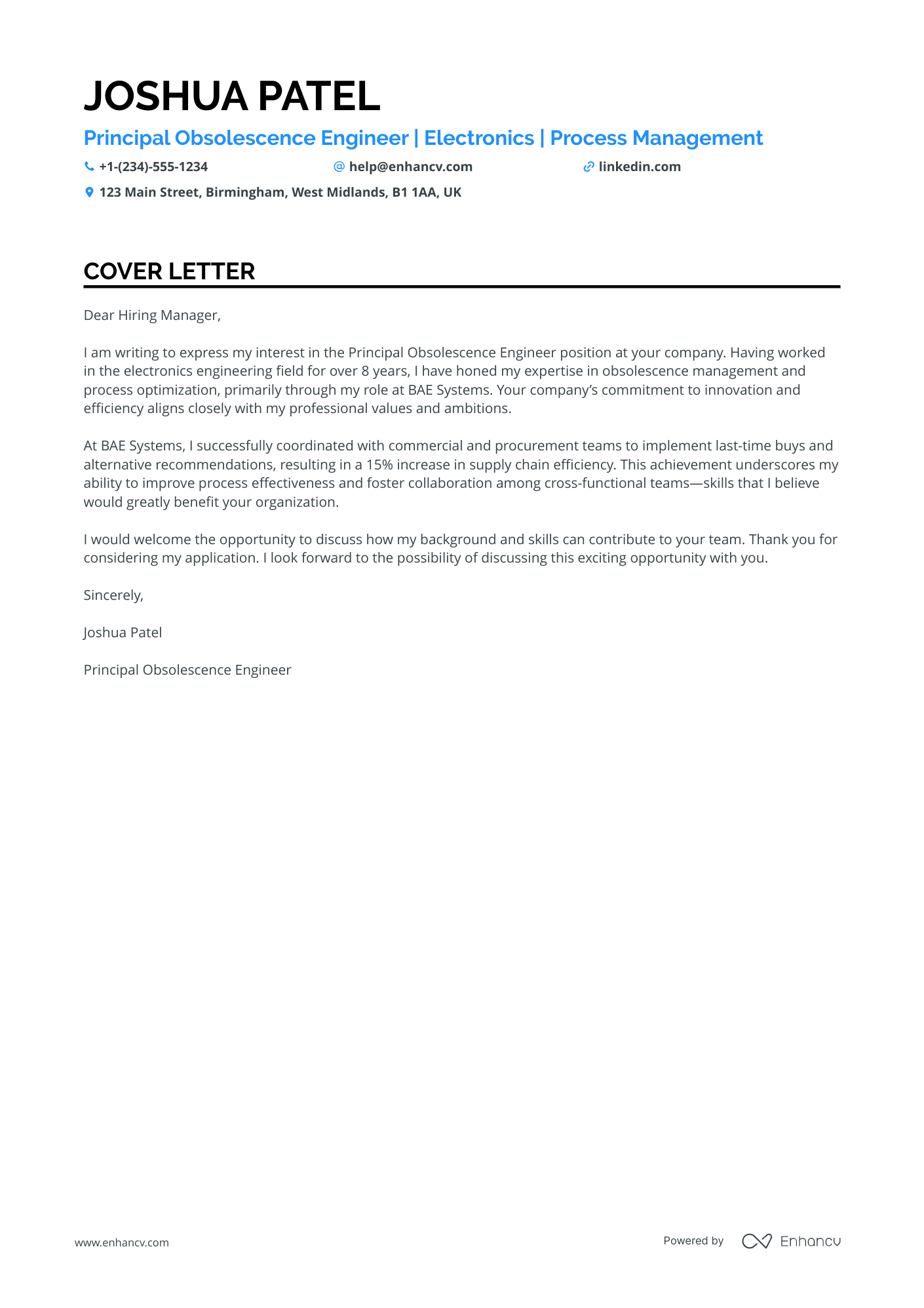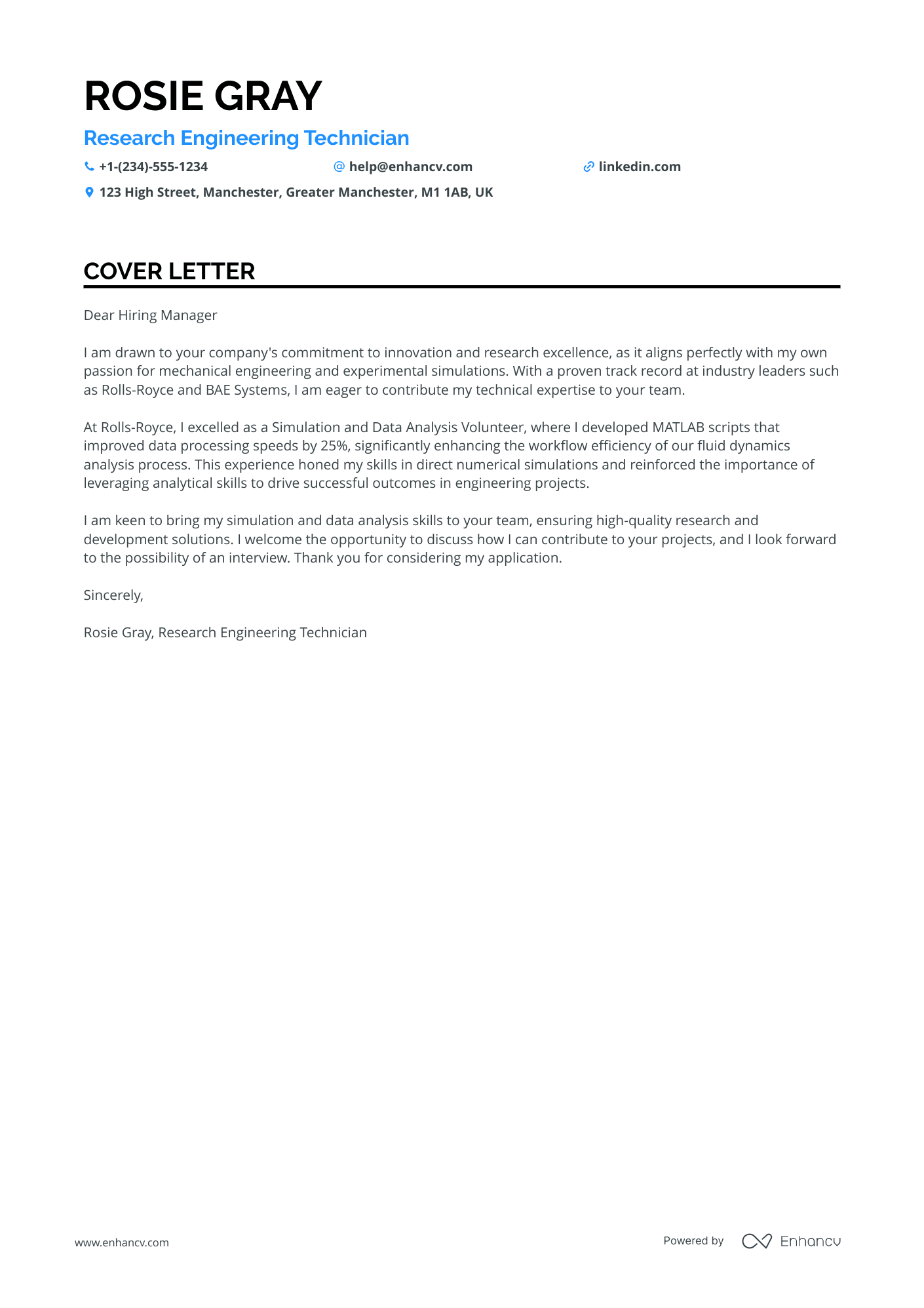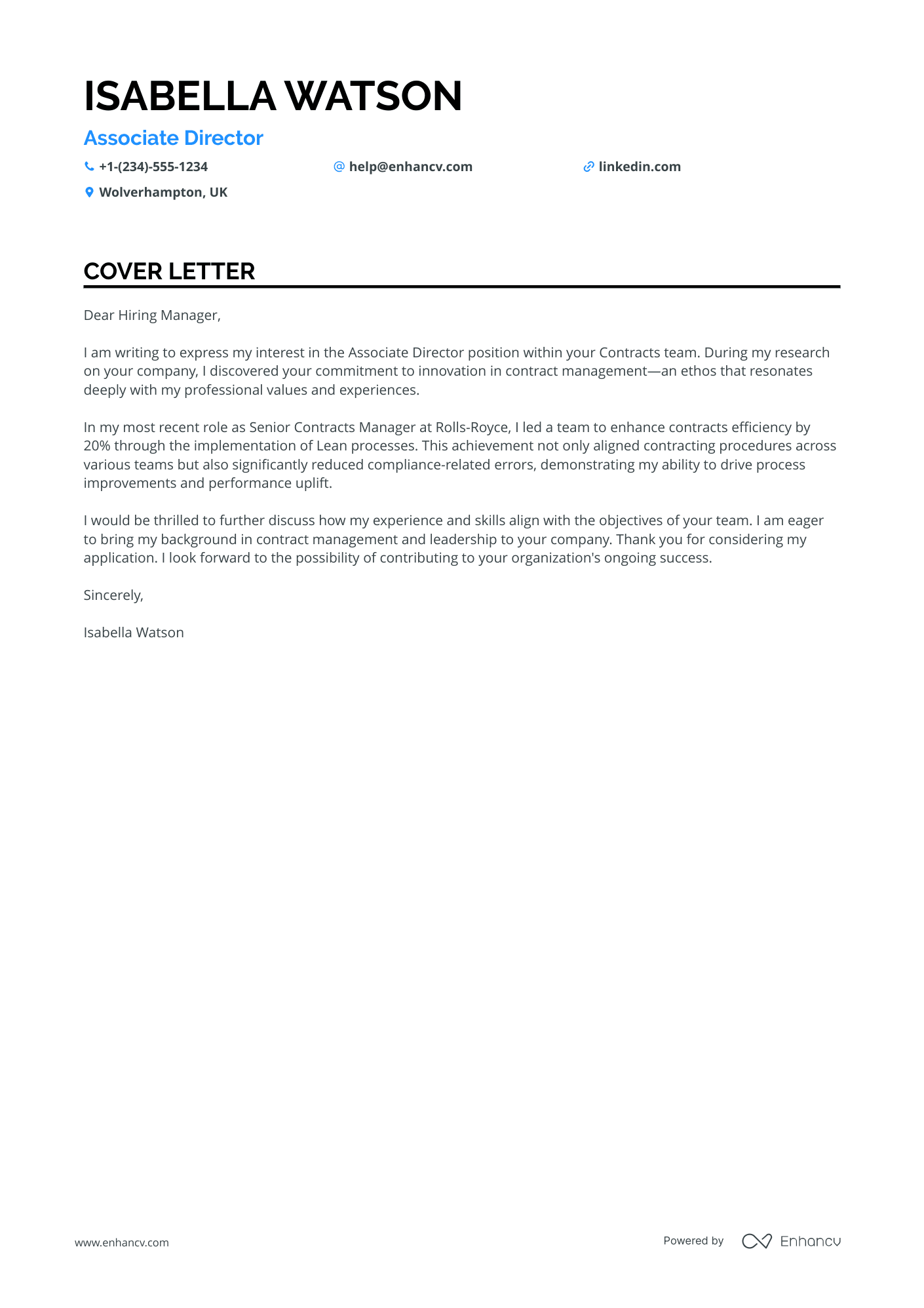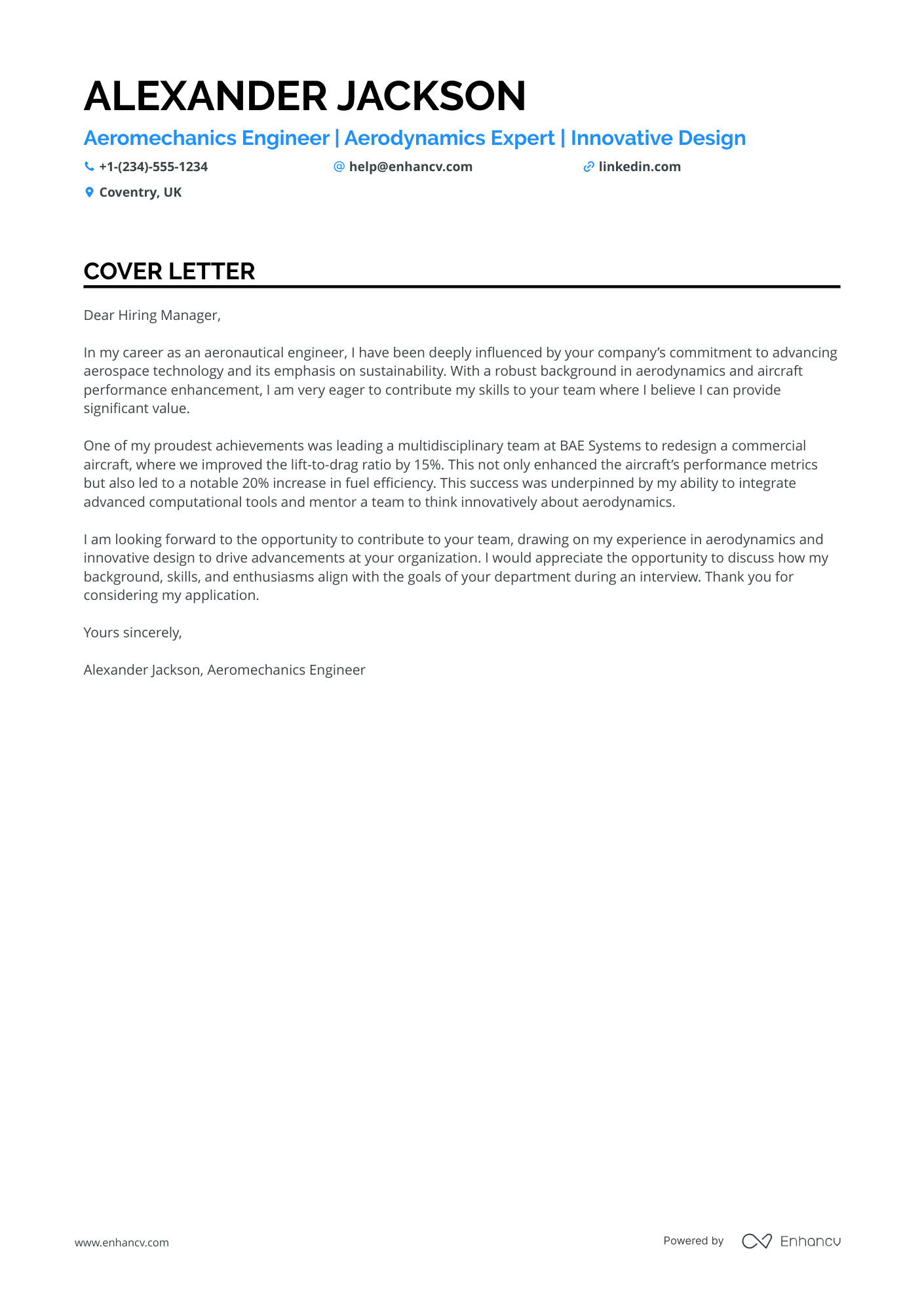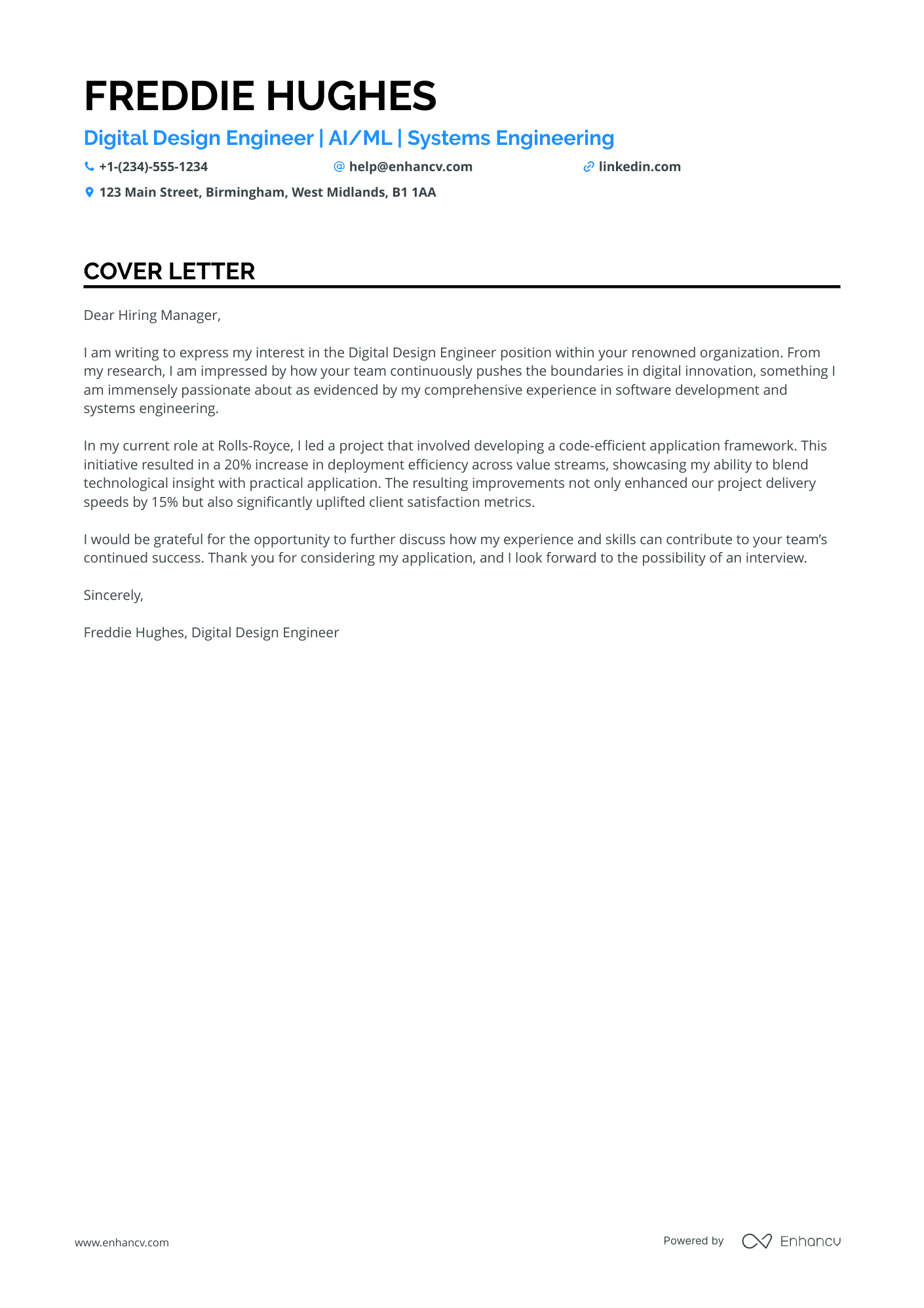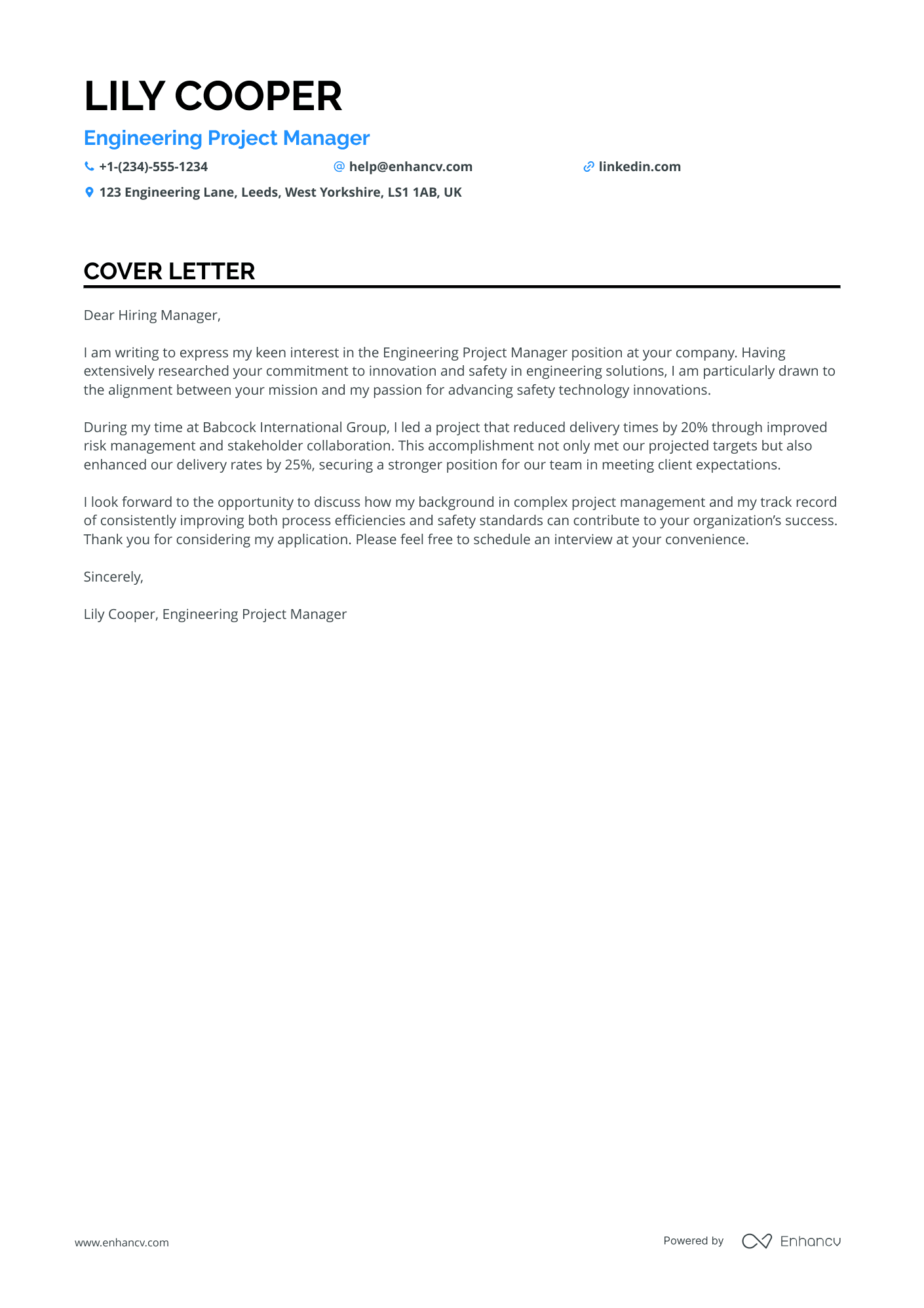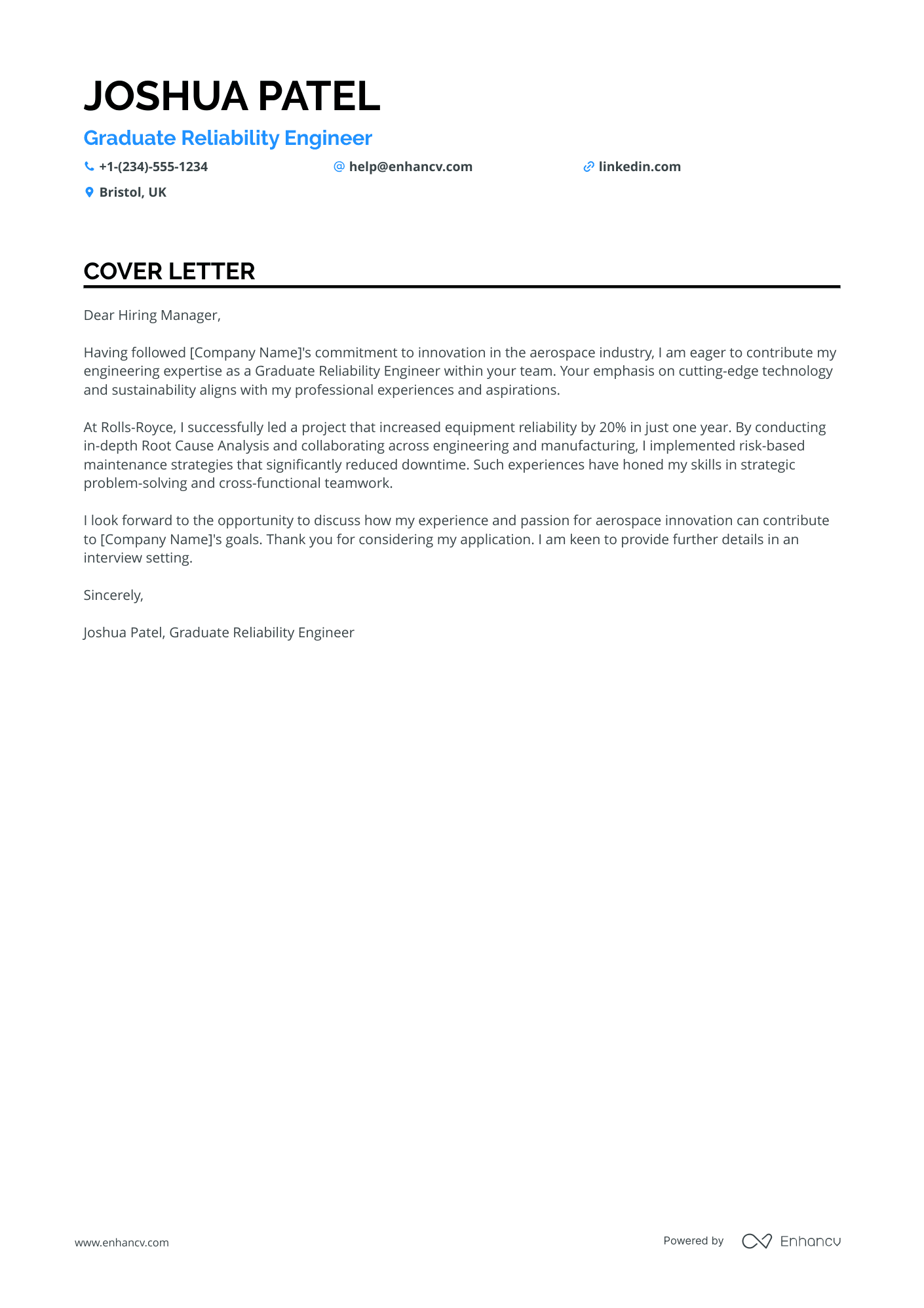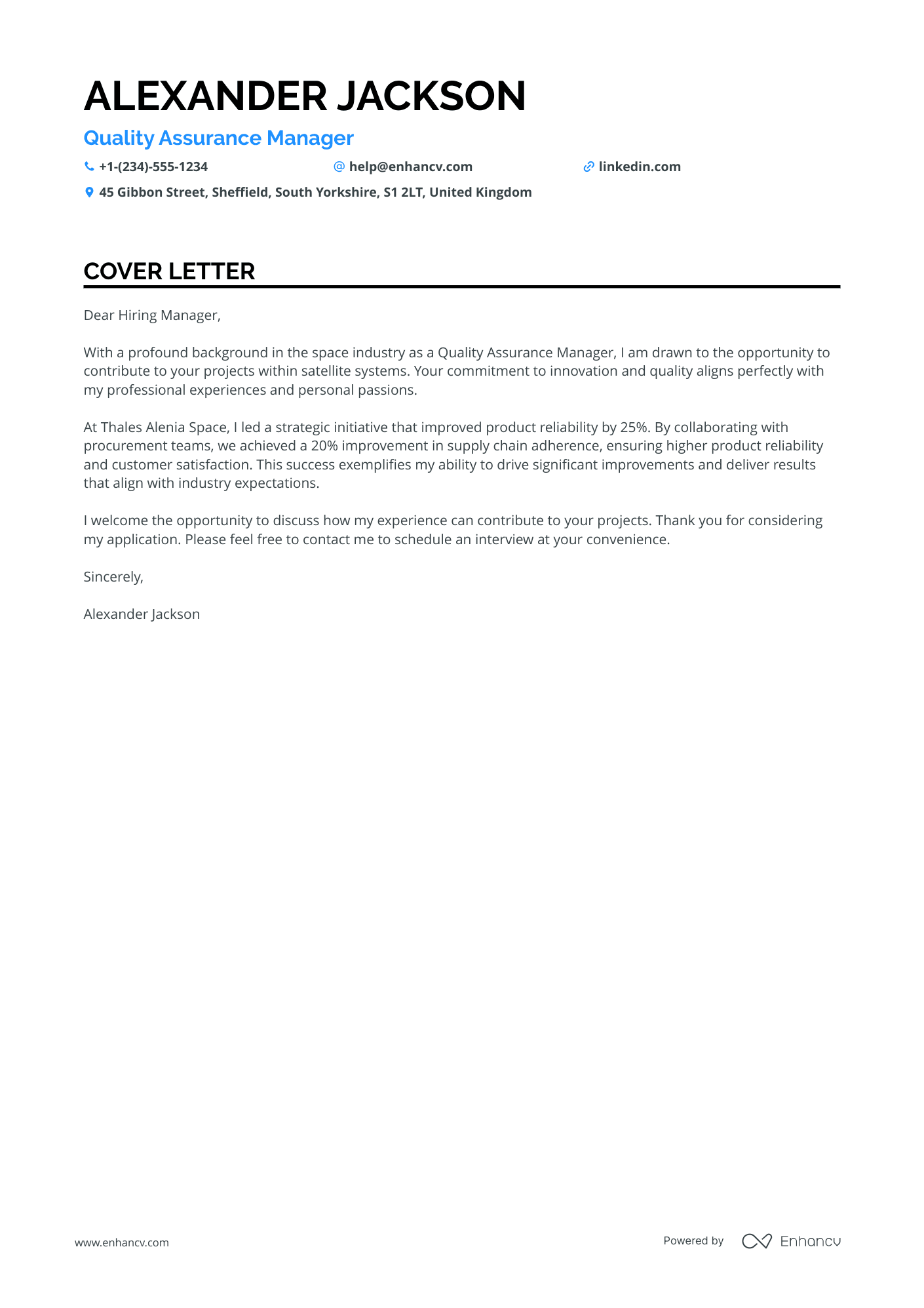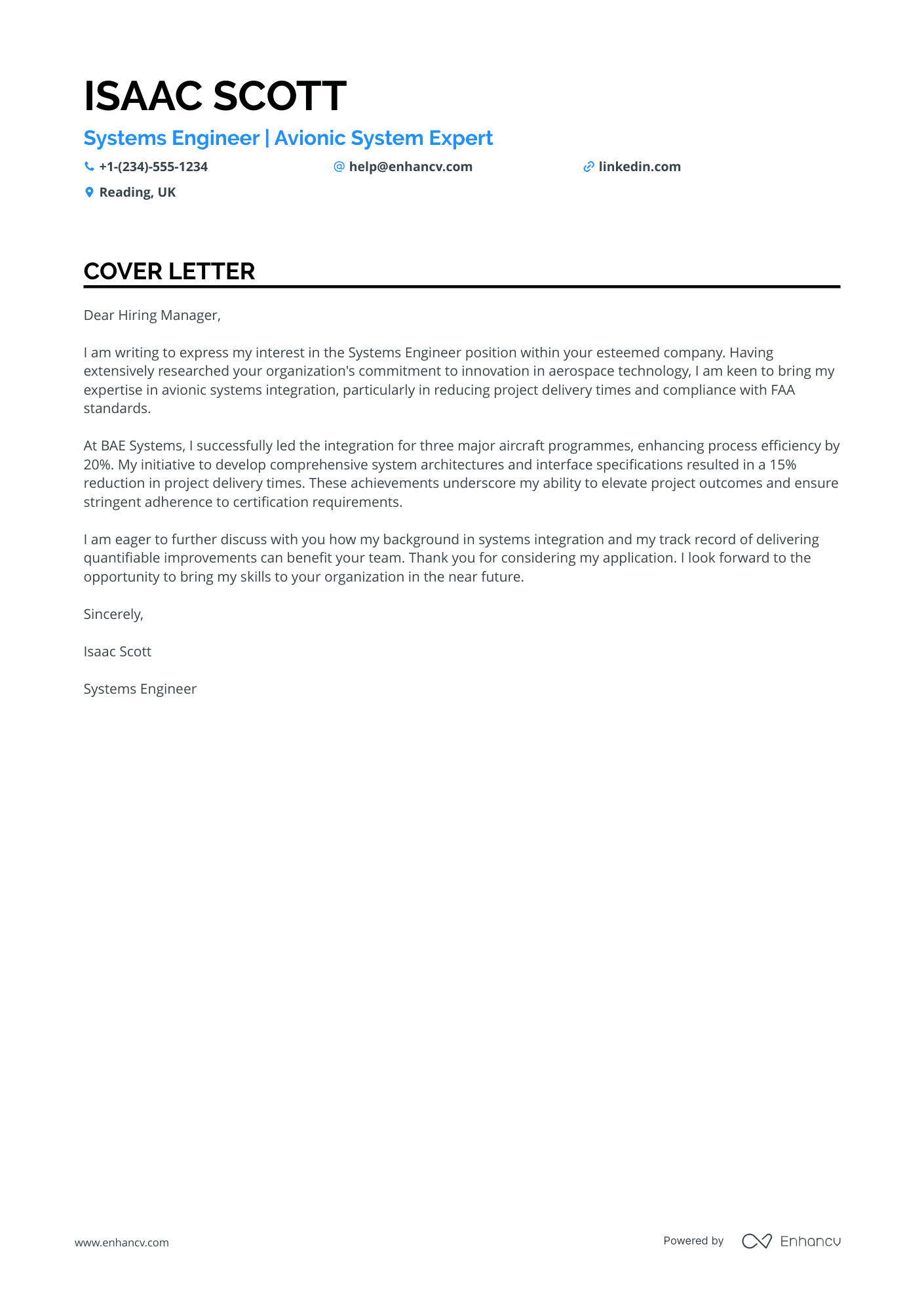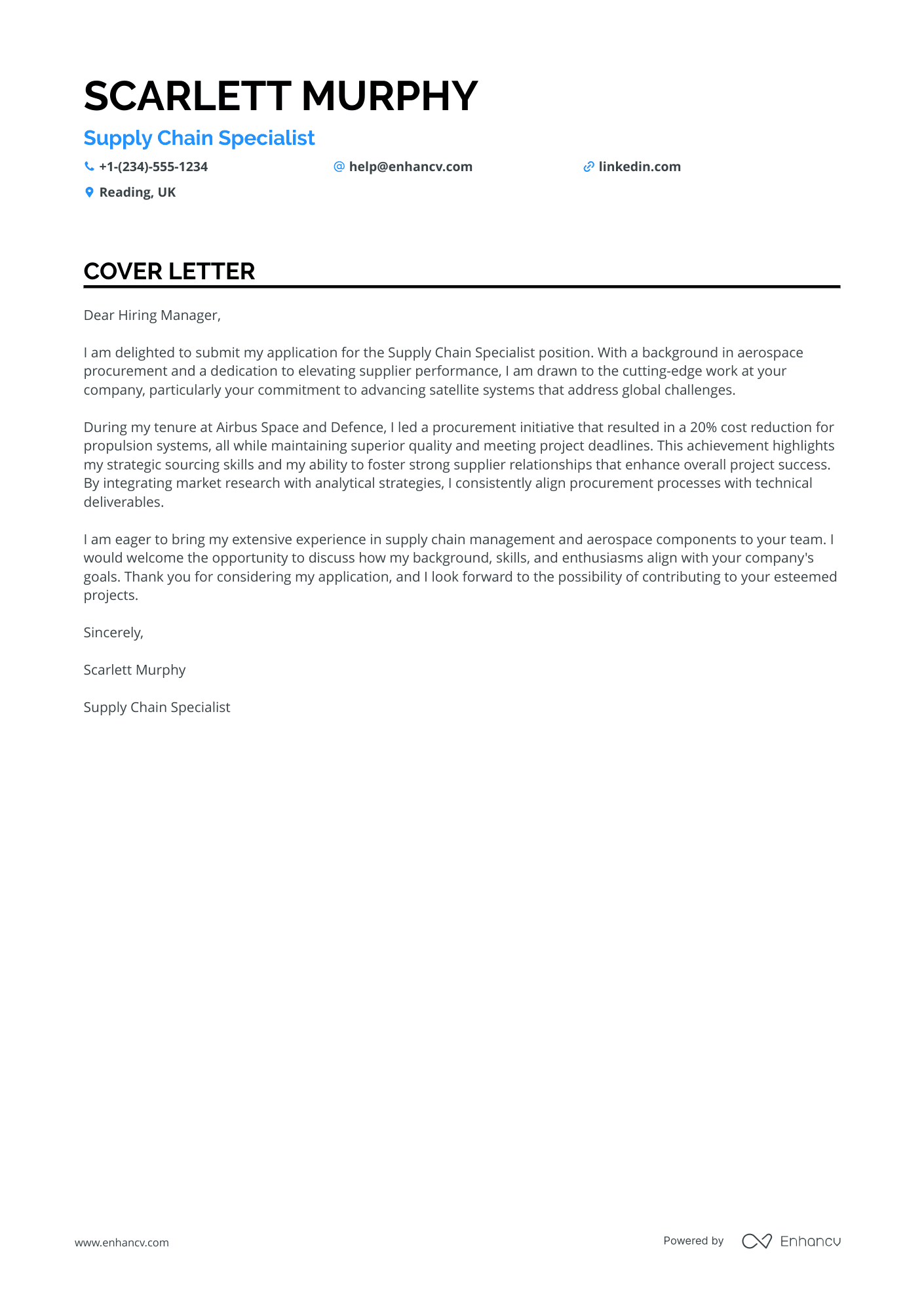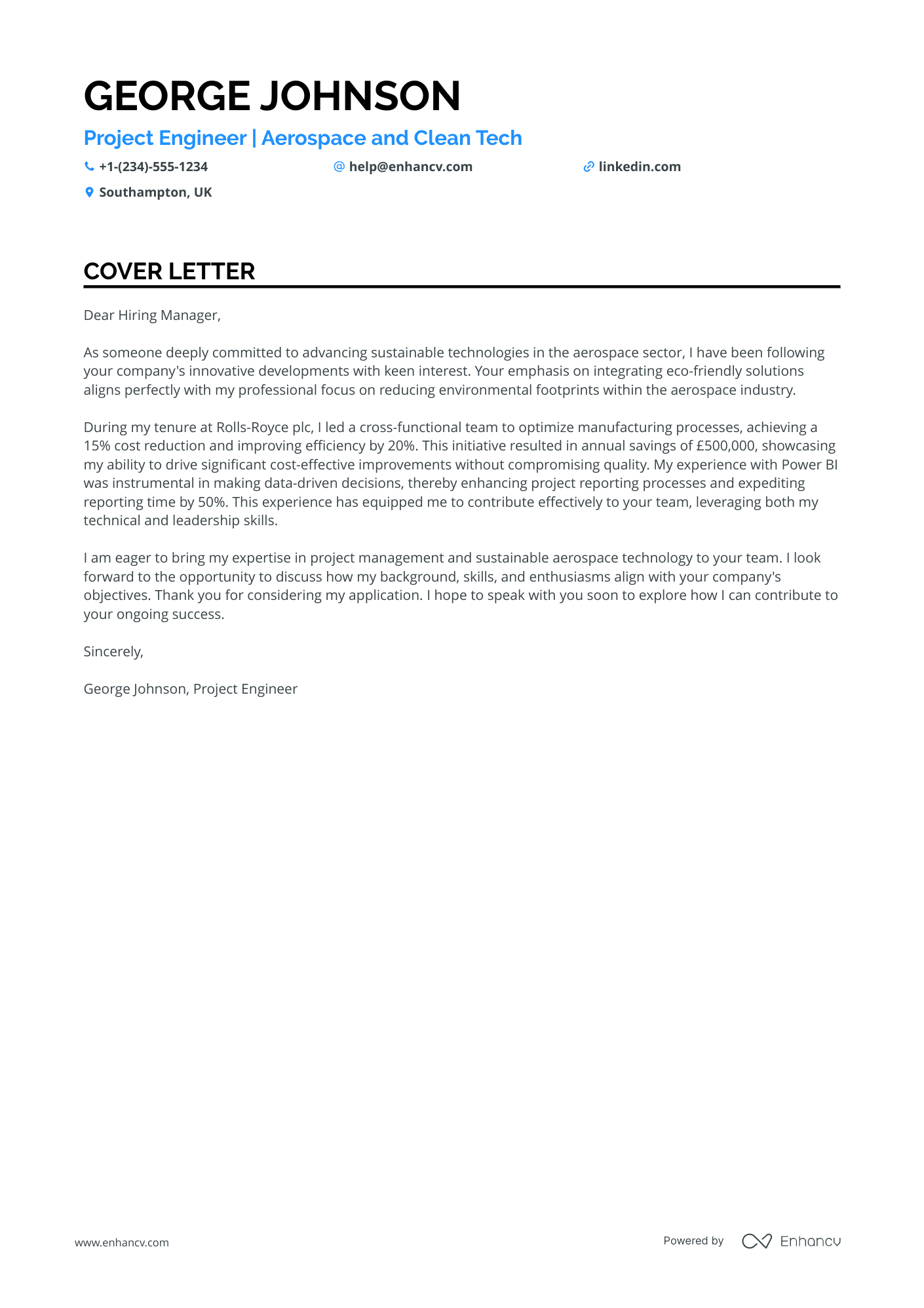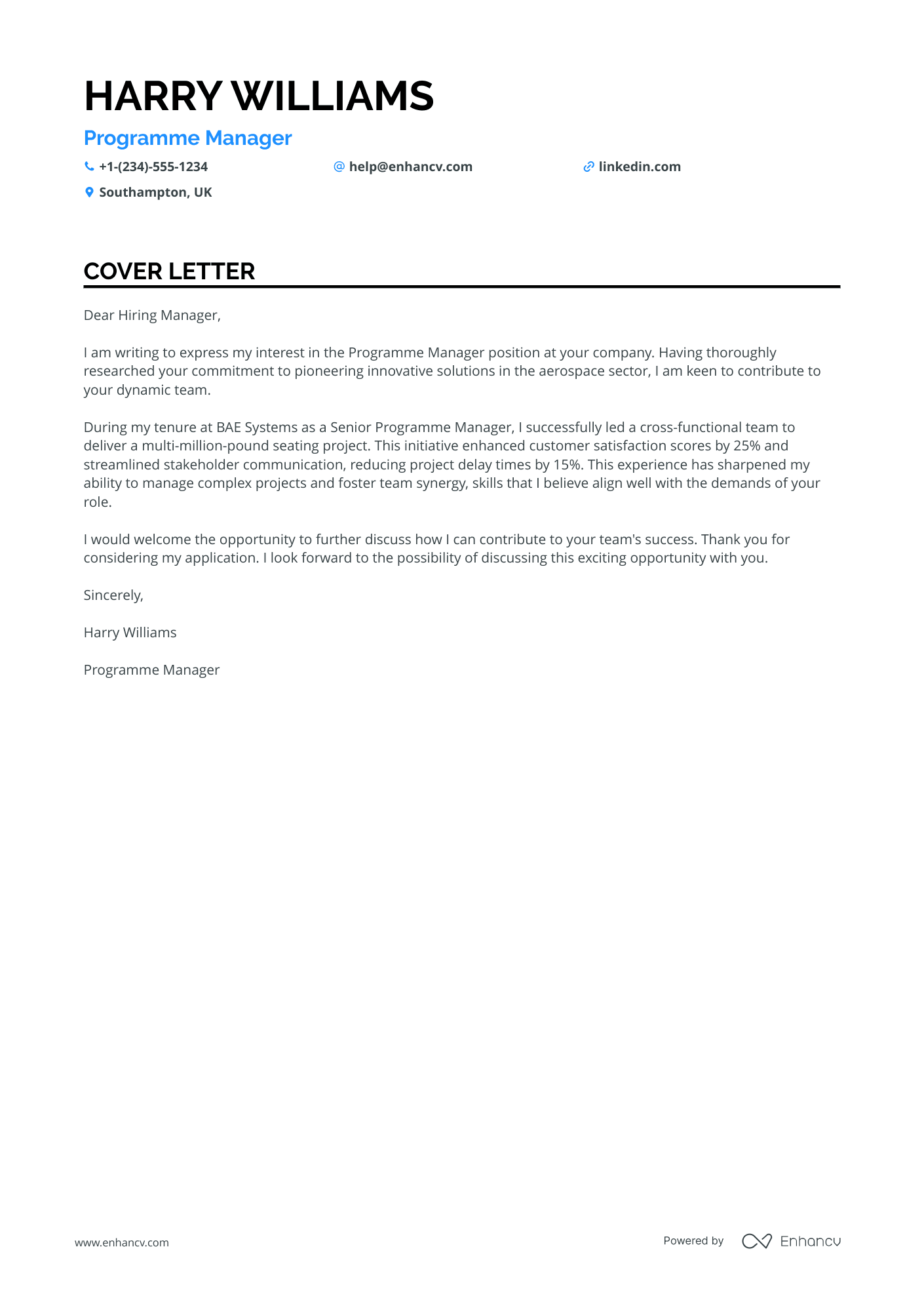When you start applying for jobs, you quickly realise that including a cover letter with your CV is a excellent way to stand out. But what should your cover letter focus on?
Should it emphasise your key achievements or simply list your responsibilities? And how can you effectively demonstrate that you're the ideal fit for the role?
One of the most common mistakes candidates make is either underselling themselves or overstating their experience.
In this guide, you’ll learn how to craft a compelling cover letter by showcasing your most significant professional achievement and telling the story behind it.
Cover letter examples for aerospace engineering
By Experience
Senior Aerospace Engineering Consultant
- Specific Experience and Impact: The candidate effectively highlights their experience in leading multidisciplinary teams and achieving quantifiable results, such as enhancing client satisfaction by 20% and accelerating certification timelines by 15%.
- Relevant Skills and Knowledge: The candidate showcases their expertise in essential processes and standards like the ASPIRE Process and Defence Standard 00-970, which are crucial for certification in the Aerospace and Defence industry.
- Educational Background: The inclusion of a Master’s in Aerospace Engineering and a Bachelor’s in Mechanical Engineering provides a solid educational foundation relevant to the role.
- Achievements: Important accomplishments, like leading a major certification project under budget and ahead of schedule, demonstrate the candidate's ability to deliver results efficiently.
Aerospace Systems Engineering Lead
- Louis Wood effectively highlights his specialised skills in requirements management and systems design, crucial for a Systems Engineer in the defence sector. His proficiency with tools like DOORS and Polarion is emphasised, showcasing his technical capabilities relevant to the role.
- The cover letter underscores the candidate's achievements, such as improving system integration efficiency by 30% and increasing detection accuracy by 20%. These quantifiable results demonstrate his ability to drive significant enhancements within complex systems.
- Louis showcases his deep industry experience, with 7+ years of expertise in defence mission systems. He illustrates his career progression from a Junior Systems Engineer to a Senior Systems Engineer at reputable companies, underscoring his capacity for leadership and impactful contributions in high-stakes environments.
- The inclusion of pursued courses such as "Advanced Systems Engineering" and certifications in Polarion requirements management signifies a commitment to ongoing professional development and mastery of niche tools essential for the role.
Principal Aerospace Engineer
- Role-Relevant Experience: The cover letter effectively highlights Joshua Patel's 8 years of experience in obsolescence management, which is directly relevant to the role of a Principal Obsolescence Engineer.
- Key Achievements: The letter includes specific achievements, such as improving supply chain efficiency by 15% and enhancing process effectiveness by 20%, showcasing Joshua's impact on his previous organisations.
- Technical Skills: Skills in Electronic Component Engineering, Supply Chain Processes, and Obsolescence Management are prominently featured, aligning well with the requirements of the role.
- Relevant Education and Courses: The inclusion of a Master's degree in Electronic Engineering and courses like Advanced Obsolescence Management demonstrates Joshua's dedication to expertise in his field.
Aerospace Engineering Operations Manager
- Highlighting the "Lean Six Sigma Green Belt" certification is crucial for a role focused on lean manufacturing and process improvement, as it demonstrates specialised knowledge and capabilities in implementing lean techniques.
- Emphasising achievements like "Production Capacity Boost" and "Lean Process Improvement" connects directly to the role's goals in enhancing efficiency and productivity, showcasing tangible results of strategic planning and lean implementation skills.
- Detailing successful project management experiences, such as achieving a "25% reduction in lead times," underscores the candidate's ability to manage complex operations and deliver results under pressure, which is critical for an Operations Manager.
- Including significant experiences with "SIOP Process" and "ERP/MRP Systems" highlights the candidate's expertise in sophisticated planning and resource management tools essential for optimising manufacturing operations.
Aerospace Engineering Intern
- Highlight Relevant Experience: The cover letter effectively outlines experience in experimental simulations and data analysis, specifically with renowned companies like Rolls-Royce and BAE Systems, which strengthens credibility for research roles.
- Technical Proficiency: Emphasising expertise in programming languages such as Matlab, Python, and C++ aligns well with the technical demands of a Research Engineering Technician role, showcasing the candidate's preparedness for technical challenges.
- Showcase Publications: Mentioning co-authorship of technical papers accepted in peer-reviewed journals is a powerful testament to the candidate's research capabilities and contributions to the field.
- Highlighting Educational Background and Courses: Presenting a Bachelor of Science in Mechanical Engineering along with relevant courses like Computational Fluid Dynamics positions the candidate as well-prepared and continually improving in the core knowledge areas of the role.
Aerospace Engineering Director
- Highlight Relevant Experience: Emphasise over 10 years of experience in contract management and team leadership roles, showcasing the candidate's strong foundation for the Associate Director role.
- Quantify Achievements: Use specific percentages and figures, such as the 20% increase in contract efficiency or the 15% increase in revenue, to demonstrate the impact of past work and skills effectively.
- Skill Emphasis: Point out specialised skills like Federal Acquisition Regulations, negotiation, and Lean processes, which are critical for strategic contracts management and the Associate Director position.
- Leadership and Mentoring: Focus on leadership experience, highlighting the ability to enhance team performance by mentoring and coaching, important for an Associate Director role commanding team leadership.
Entry-Level Aerospace Engineer
- Highlight Specific Experience: The cover letter underscores Alexander Jackson's specific achievements in aerodynamics and aeromechanics, providing concrete metrics such as a 20% improvement in flight efficiency. This showcases his ability to deliver measurable results, which is crucial in engineering roles.
- Relevant Certifications and Education: Emphasising certifications like "Advanced Computational Fluid Dynamics" from MIT and formal education from prestigious institutions like the University of Cambridge and University of Bristol adds credibility and demonstrates a strong foundation in technical knowledge.
- Showcase Leadership and Teamwork: The letter highlights leadership roles and cross-functional collaboration experience, such as leading a multidisciplinary team and mentoring junior engineers, which are key in roles that require managing complex projects and teams.
- Address Problem-Solving Skills: By detailing the implementation of advanced computational tools and innovative design improvements, the cover letter effectively conveys problem-solving abilities and a proactive approach to addressing engineering challenges.
Aerospace Engineering Design Manager
- Highlighting Achievements: The cover letter effectively showcases specific achievements such as the cost-saving initiative and AI technology implementation, providing evidence of the candidate's impact in previous roles.
- Relevant Certifications: The inclusion of certifications like "Advanced AI/ML Applications" and "Systems Engineering Principles Certification" substantiates the candidate's expertise and dedication to continuous learning within specialised fields.
- Experience with Cross-Functional Teams: Mentioning collaboration with cross-functional teams and engaging with internal clients demonstrates the candidate's ability to work effectively in diverse environments, which is crucial for roles that require interdisciplinary collaboration.
- Emphasis on Digital and AI Expertise: The cover letter emphasises the candidate's strength in AI/ML applications and digital innovation, aligning well with the Digital Design Engineer role that requires modern technological insights.
By Role
Aerospace Engineering Technician
- Highlight specialised certifications: Mention relevant courses such as "Advanced Aircraft Diagnostics" and "Aerospace Systems Engineering" to emphasise expertise in the latest diagnostic technologies and aerospace systems essential for aeronautical engineering roles.
- Quantify achievements: Clearly indicate the impact of your work, such as increasing operational efficiency by 15%, reducing downtime by 12%, and enhancing fuel efficiency by 7%, to demonstrate your capability to deliver results.
- Emphasise critical skills and experiences: Focus on key skills such as mechanical diagnostics, problem-solving, and preventive maintenance, and cite tangible experiences from reputable companies like Rolls-Royce and Airbus Group to establish credibility and relevance.
- Showcase passion for industry advancements: Highlight interests in aviation technologies and renewable energies to align with the industry's push towards sustainable and innovative solutions, displaying a forward-thinking mindset.
Aerospace Engineering Project Manager
- Specific Achievements: Highlighting specific achievements, like reducing project delivery time by 20% and consistently maintaining project costs 10% below budget, demonstrates effectiveness and directly aligns with the role of a Project Manager.
- Certifications and Courses: Mentioning relevant certifications, such as the Risk Management Certification by the Institute of Risk Management, underscores a specialised skill set that's crucial for a management role dealing with complex engineering projects.
- Language Proficiency: Including language proficiency, especially in widely spoken languages like Spanish, enhances the candidate's appeal for multinational companies or projects needing bilingual interactions.
- Passion and Motivation: Describing passions such as Safety Technology Innovations can convey a strong alignment with the company's mission and the specific role's focus on safety within engineering projects.
Aerospace Engineering Research Associate
- Use of specific job titles in the header can immediately tailor the cover letter to complement the job role, such as "Research Associate" and "Nanosatellite Operations."
- Including a measurable impact in the experience section, like improving system efficiency by 25%, can demonstrate a candidate's ability to achieve tangible results in their contributions.
- Mentioning relevant courses and certifications such as "Nanosatellite Design and Operations" and "Advanced Spacecraft Systems Engineering" highlights commitment to continuous learning and expertise in the field.
- Listing skills and achievements in space-related projects can provide evidence of capabilities, such as successful satellite launches and mentoring recognitions, which are highly relevant to the aerospace industry.
Aerospace Engineering Analyst
- Highlighting Relevant Experience: The cover letter effectively emphasises Arthur Davies' experience in trajectory optimisation and rocket propulsion systems, showcasing the candidate's relevance for aerospace roles dealing with advanced rocket technologies.
- Specific Impact and Achievements: Details such as the 30% enhancement in analysis speed and a 20% increase in accuracy demonstrate the candidate's tangible contributions and impact on projects, which is crucial in technical roles focused on performance and innovation.
- Technical Skills and Software Proficiency: Emphasising MATLAB and Python proficiency highlights Arthur's capability to handle complex engineering problems and software development, skills highly valued in aerospace engineering roles.
- Education and Certifications: Mentioning advanced specialised courses like “Advanced Trajectory Optimisation” and a Master’s degree in Aerospace Engineering helps establish credibility and expertise in the field.
Aerospace Propulsion Engineer
- Emphasises leadership and strategic skills by highlighting roles in optimising propulsion processes and mentoring junior engineers.
- Utilises quantified achievements to demonstrate impact, such as cost reductions, increased efficiency, and improved product reliability, showcasing value to potential employers.
- Showcases relevant technical expertise through specific mentions of software proficiencies like CFD software, MATLAB, and ANSYS, pertinent to the role of a Strategic Propulsion Engineer.
- Highlights professional development through specialised courses and continued education, emphasising commitment to staying updated with industry advancements.
Aerospace Structural Engineer
- Highlight Relevant Experience: Emphasise the candidate's three years of experience in reliability engineering, showcasing their understanding and expertise in the field, which makes them a valuable asset for the role of a Graduate Reliability Engineer.
- Focus on Skills and Achievements: Illustrate proficiency in Root Cause Analysis and critical assessments, supported by quantifiable achievements like enhancing equipment reliability by 20%, which can clearly demonstrate impact and success in previous roles.
- Emphasise Industry-Specific Knowledge: Underline experiences specific to aerospace like participation in capital projects at Rolls-Royce plc and involvement with metallic component design at Airbus Group to emphasise familiarity with industry challenges and improvements.
- Education and Certifications: Mention the candidate's advanced education (MSc in Aerospace Engineering) and relevant certifications like Root Cause Analysis Certification, to strengthen their profile and demonstrate a commitment to professional development.
Aerospace Engineering Quality Assurance Manager
- Emphasise Relevant Industry Experience: The cover letter effectively highlights Alexander Jackson's extensive 8-year experience in quality assurance within the space industry, specifically his proficiency in European Space Agency standards, which is crucial for the role.
- Detail Specific Achievements: It provides concrete examples of achievements, such as reducing non-conformance rates by 30% and enhancing product reliability by 25%, adding substantial value to his profile as a candidate.
- Showcase Leadership and Team Skills: The document describes his success in leading teams and strategic initiatives, with examples of improved bid acceptance rates (85%) and supply chain quality adherence (20%).
- Highlight Education and Professional Development: The mention of a Master’s degree in Quality Management and completion of space-specific courses underlines his commitment to continual professional development in alignment with industry requirements.
Aerospace Engineering Department Head
- Highlighting Industry-Specific Experience: The cover letter effectively emphasises Max Wright's extensive 15-year experience in the Aerospace sector, underscoring expertise in strategy development, operational excellence, and valuable achievements such as a 25% revenue growth and award-winning product recognition.
- Emphasising Operational Achievements: Achievements in operational efficiency, process optimisation, and cost reduction (30% efficiency boost) are foregrounded, indicating a strong focus on enhancing operational frameworks essential for an Aerospace Product Specialist role.
- Showcasing Leadership and Strategy Implementation: The cover letter elucidates Max's leadership capabilities, highlighting successful mentorship that increased team productivity by 20% and aligning regional strategies resulting in seamless global operations.
- Relevance of Educational Background: The educational history, including an MBA and a Bachelor's in Aeronautical Engineering, demonstrates a solid foundation and comprehensive understanding of aeronautics and business management relevant to the role.
Aerospace Flight Systems Engineer
- Highlighting FAA Certification Expertise: Emphasising expertise in FAA certification, which is a critical requirement for avionic systems engineers, demonstrates capability in ensuring safety and compliance standards in aircraft systems.
- Showcasing System Integration Skills: Detailing systems integration experience across various roles highlights the candidate's proficiency in managing complex avionic systems and improving integration processes efficiently.
- Emphasising Problem-Solving Achievements: Illustrating problem-solving capabilities with concrete achievements, such as enhancing system reliability by identifying and resolving integration issues, showcases effectiveness in overcoming technical challenges.
- Focusing on Relevant Certifications and Courses: Mentioning relevant certifications and courses, such as the Certified Systems Engineer Professional, underscores a commitment to continuous professional development and a deep understanding of systems engineering principles.
Aerospace Engineering Procurement Specialist
- Highlight Relevant Experience: The cover letter effectively showcases Scarlett's vast experience in supply chain management, specifically within the aerospace and satellite sectors, making her a strong candidate for roles in these fields.
- Emphasise Achievements: It effectively lists key accomplishments, like achieving a 20% cost reduction and improving supplier performance by 22%, which underscore her ability to deliver tangible results in strategic sourcing and supplier management.
- Mention Specialised Certifications: The mention of a Satellite Systems Certification from the Royal Aeronautical Society highlights her specialised knowledge, which is critical for roles that require technical expertise in satellite systems.
- Demonstrate Passion and Interest: Including her passion for space technology and data analysis indicates a genuine interest and ongoing engagement with relevant industry trends, which can be appealing to potential employers seeking committed candidates.
Aerospace Engineering Product Development Engineer
- Emphasising Industry Experience: The cover letter effectively highlights the applicant's extensive experience in managing complex aerospace projects and their significant contributions to cost savings and efficiency improvements.
- Highlighting Relevant Skills: Skills such as MS Project and Power BI, crucial for a Project Engineer role, are prominently mentioned, showcasing the candidate's technical prowess.
- Demonstrating Leadership and Teamwork: The candidate's leadership in optimising manufacturing processes and coordinating teams is highlighted, underscoring their ability to lead cross-functional projects and drive successful outcomes.
- Passion for Sustainability: The candidate passionately expresses their enthusiasm for sustainable and low-emission aerospace technology, aligning their personal passions with industry trends.
Aerospace Engineering Programme Manager
- Relevance to Aerospace Industry: The cover letter effectively highlights relevant experience and expertise in the aerospace industry, demonstrating a clear alignment with the role requirements. Specific mention of leading a high-value seating programme at BAE Systems enhances credibility.
- Accomplishments and Impact: Emphasising quantifiable achievements, such as a 25% increase in client satisfaction and a 40% growth in client portfolio, provides solid evidence of the candidate's impact and value in past roles.
- Specialised Skills and Certifications: Noting skills and certifications related to aerospace standards and project management, such as the "Advanced Aerospace Project Management" course, showcases technical competence and a commitment to ongoing professional development.
- Cross-functional Leadership: Highlighting the ability to lead cross-functional teams and manage complex projects speaks to the candidate's leadership capabilities and ability to drive diverse teams towards common goals, a key asset for the Programme Manager role.
Aerospace Engineering cover letter example
Henry White
Glasgow, UK
+44 1234 567890
help@enhancv.com
- Emphasize Project Management Experience: Highlighting successful project executions, especially those involving multimillion-pound budgets, can demonstrate an applicant's ability to handle complex and high-stakes projects effectively.
- Showcase Leadership Skills: Mentioning leadership roles, such as leading a team of engineers, helps illustrate an applicant's capability in managing teams and driving projects forward.
- Quantify Achievements: Using specific metrics, like a 25% increase in efficiency or a 40% enhancement in system reliability, allows the candidate to back up their claims with tangible evidence of past success.
- Align Personal Goals with Company Objectives: Expressing a commitment to the company's mission to innovate within the aerospace sector demonstrates enthusiasm and a long-term vision that aligns with the employer's goals.
Importance of cover letters in the United Kingdom
Cover letters are a crucial part of your application, offering additional details beyond your CV.
Here’s why they’re essential:
- Supporting your CV: Now's your opportunity to provide some context for your experience, with more information on your key achievements and how your profile could benefit the position and organisation to which you're applying.
- Showcases your character: Taking the time to write a cover letter demonstrates that you’re proactive, organised, ambitious, and genuinely interested in the role.
- Reflects your career goals: Use the cover letter to outline your long-term career career aspirations and how this role aligns with your broader plans.
What UK employers expect from a cover letter
When writing your cover letter for a UK employer, it’s important to keep several things in mind. First, you need to conduct a thorough research, which includes reading up on the company’s website, recent news, and their presence on social media. Understanding the company’s latest achievements and its overall mission will allow you to tailor your letter to their specific needs.
Next, focus on the company’s core values. Whether they value teamwork, innovation, or community involvement, highlighting how your own experience aligns with these principles is essential.
Finally, don’t forget to match your skills to the job’s requirements. Study the job description carefully and pick out the most important qualifications or competencies. Then, provide evidence of how you meet those criteria with concrete examples from your past work experience.
How to format a aerospace engineering cover letter
Your cover letter is your opportunity to make a strong impression, so its structure must be professional and clear.
Here's an overview of how a UK cover letter should be structured:
- Begin with your address and contact details at the top.
- Include the employer’s name and address directly below.
- Add the date to the left or right of the page.
- Use an appropriate greeting, such as 'Dear Mr Smith' or 'Dear Sir/Madam.'
- Open with a strong introductory paragraph.
- Develop your points in the middle paragraphs, focusing on relevant skills and experience.
- Close with a concise conclusion, reiterating your interest and suitability for the role.
- Sign off formally with your name and signature.
The software used to match your profile to the job, Applicant Tracking Systems (ATS), won’t scan your cover letter. Instead, the cover letter reads as a more personalised note to the recruiter.
When it comes to choosing a font, consider modern options like Lato, Rubik, or Chivo, which should also be applied to your CV to maintain a consistent appearance.
Additionally, your cover letter should be single-spaced with 1-inch (2.5 cm) margins on all sides (our templates are pre-set with these specifications so you can focus on your cover letter content).
Finally, always send your cover letter as a PDF to preserve the formatting and prevent edits.
How to write your aerospace engineering cover letter salutation
It's never advisable to begin your cover letter with 'Dear Sir/Madam', as it sounds comes across as impersonal.
Take the time to find out who is hiring for the role and address them directly in your cover letter greeting (e.g., 'Dear Mrs Chanceworth', 'Dear Harrod').
If you're uncertain where to find the hiring manager’s name, check the company website, look on LinkedIn, or send a courteous email requesting this information. Don't hesitate to ring reception either—they are unlikely to refuse to assist.
How to write your aerospace engineering cover letter intro
One of the best ways to grab a hiring manager's attention? Show them the unique value you'd add to the team.
Review the skills or requirements listed in the posting and draw connections to your previous work experiences.
Focus on specific (and quantifiable) accomplishments and qualifications that align with the job description to make a strong first impression.
How to write your aerospace engineering cover letter body
Which makes for a stronger cover letter body: a long-winded account of everything you’ve ever done, or a focused achievement that’s directly relevant to the job?
Hint: recruiters prefer the second.
When writing your cover letter, select your most impressive achievement that:
- Directly aligns with the job description and role.
- Is quantifiable with tangible metrics like numbers or percentages.
- Maps out your hard and soft skills, showcasing what makes you unique.
- Tells the story of the impact you could have on the organisation.
How to write a closing paragraph
Looking to leave a lasting impression with your cover letter closing?
Then, you should certainly end with a promise—one that outlines what you aim to achieve in the role. Ensure your goals are realistic and align with the company’s needs.
You might also include a call to action, enquiring when you can expect to hear back and what the next steps in the hiring process will be.
Conclusion
Your cover letter is an opportunity to showcase your personality and skills to potential employers. Start by addressing the hiring manager by name and tailoring your content to reflect the role’s requirements.
Include a specific example of your greatest achievement to illustrate your suitability for the position, while also expressing your enthusiasm for the company. Remember to format your letter professionally, ensuring it aligns seamlessly with your CV.

